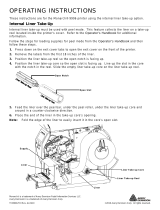
Table of Contents i
TABLE OF CONTENTS
INTRODUCTION ...................................................................................................................................... 1-1
Audience ........................................................................................................................................... 1-1
Using the Display ............................................................................................................................... 1-1
Accessing the Start Menu ................................................................................................................ 1-1
Reading the Task Bar ...................................................................................................................... 1-2
Using the Input Panel ......................................................................................................................... 1-2
Entering Data Using the Input Panel ................................................................................................. 1-3
ADMINISTRATIVE TOOLS ........................................................................................................................ 2-1
Setting the Date and Time ................................................................................................................... 2-1
Setting the Time Zone ......................................................................................................................... 2-2
Setting the Internet Time ..................................................................................................................... 2-2
Using Asset Tracking .......................................................................................................................... 2-3
Editing Owner Data ......................................................................................................................... 2-3
Importing/Exporting Asset Tracking Files .......................................................................................... 2-4
Printing an Asset Tracking Label ...................................................................................................... 2-4
Changing the Power Properties ........................................................................................................... 2-4
Changing the Input Panel Options ........................................................................................................ 2-6
Keyboard Options............................................................................................................................ 2-6
AlphaNumSip Options ...................................................................................................................... 2-7
Using the System Lockdown Option ..................................................................................................... 2-7
Locking the System ......................................................................................................................... 2-7
Unlocking the System ...................................................................................................................... 2-8
Locking the USB Ports ..................................................................................................................... 2-8
Changing the PC Connection ............................................................................................................... 2-9
Adding Notification Events ................................................................................................................ 2-10
Testing the Speaker.......................................................................................................................... 2-12
Viewing the System Properties .......................................................................................................... 2-12
Viewing the Printer’s Software Version ............................................................................................... 2-13
Resetting the Printer ......................................................................................................................... 2-13
Soft Reset Using the Start Menu .................................................................................................... 2-13
Hard Reset Using the Power Button ................................................................................................ 2-13
Bootloader & Factory Default Using the Control Panel ...................................................................... 2-14
USING THE SUMMIT CLIENT UTILITY ...................................................................................................... 3-1
Finding a Network .............................................................................................................................. 3-2
Creating a Profile ............................................................................................................................... 3-3
Setting a Password ............................................................................................................................. 3-5
USING WAVELINK AVALANCHE .............................................................................................................. 4-1
Starting the Utility .............................................................................................................................. 4-1
Closing the Utility ............................................................................................................................... 4-1





















